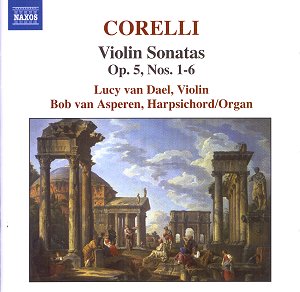Corelliís (essentially)
sonata da chiesa Op.5 collection
is one of the great sets of violin music
written in the second half of the seventeenth
century. The sonatas share rare imagination
and a sense of fluid lyricism predicated
on the stoutest of technical armouries.
This is Manze territory and indeed his
recording for Harmonia Mundi [907298.99]
is a powerfully expressive one. This
newcomer has to tackle, as do all entrants,
the locus classicus of this kind of
sonata Ė the slow introduction leading
to the first moment of arresting individuality
in the cadential passage, leading still
onwards in succeeding movements to fugal
writing and opportunities for suitable
embellishments.
Van Dael and van Asperen
are long time colleagues and have decided
that in the first six of these sonatas
(Iím assuming this is the first volume
of two Ė there are twelve sonatas in
Op.5) the accompanying instrument is
often as not the organ. Itís only in
the G minor and the A major that van
Asperen switched to the harpsichord.
For Manze Richard Egarr always plays
the harpsichord. So there are immediately
differences of approach and sonority
in their approaches. Van Dael takes
the second movement Allegro of the D
major rather slowly, almost at an Allegretto
the better, I suppose, to distinguish
it from the following faster Allegro.
And in the Adagio of the same sonata
van Asperen takes great care over his
registrations, as he is at pains to
do elsewhere. Her phrasing and articulation
in the Allegro of the B flat major is
first rate and sheís not afraid to spin
an expressive line. Maybe the concluding
Giga of the C major is a mite on the
slow side Ė but in fairness it is sensitively
shaped. But I think itís in the slow
movements that van Dael proves such
a worthy exponent, in the way for instance
that she catches the desolate heart
of the Adagio of the A major [No.6].
The recording isnít
quite ideal. Thereís some ambient noise
Ė and the organís action is audible
in the slower music, and especially
before the music quite begins. I wouldnít
place the Naxos pairing above Manze
either in terms of technical accomplishment
or recording but then Manze and Egarr
are very special here.
Jonathan Woolf
see also review
by Paul
Shoemaker and Emma Jones







